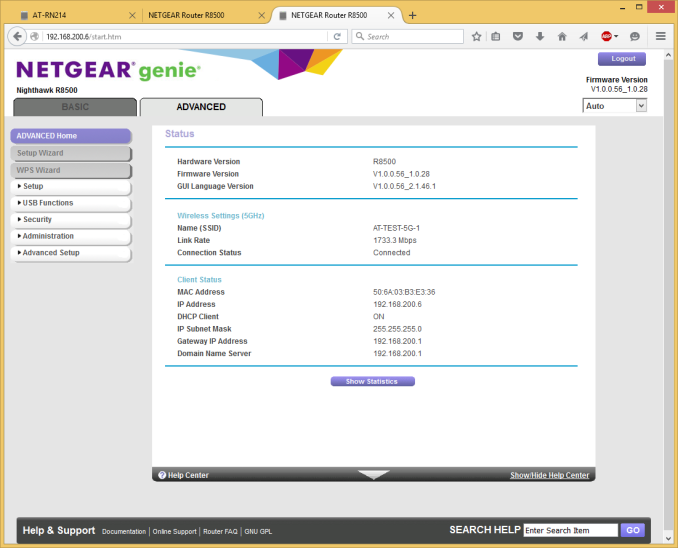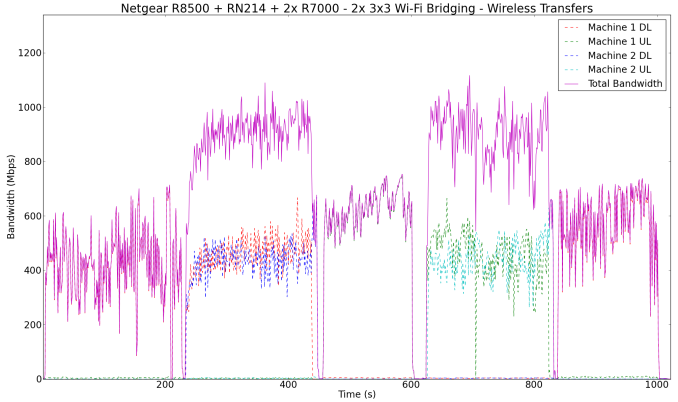Netgear Nighthawk X8 R8500 AC5300 Router Brings Link Aggregation Mainstream
by Ganesh T S on December 31, 2015 8:00 AM EST- Posted in
- Networking
- NetGear
- Broadcom
- 802.11ac
- router
The Promise of Gigabit Wi-Fi
The Nighthawk X8 R8500 is marketed as an AC5300-class router. This naturally leads consumers to wonder whether it is really possible to get gigabit Wi-Fi (considering that an AC5300 router should theoretically support up to 2165 Mbps on each of the 5 GHz bands). In order to test out this aspect, we configured another R8500 in bridge mode (this is necessary to test 4x4 Wi-Fi bridging at the maximum possible link rate because 1024-QAM works only with other Broadcom devices, and the R8500 is the only Broadcom device that also has 4x4 capabilities).
Irrespective of where we placed the bridging router relative to the main R8500, we found that the link rate never reached 2165 Mbps, but topped out at 1733 Mbps. Eventually, we settled down on keeping the bridging router around 10 ft away, but, across a drywall (in order to simulate realistic conditions). The wired PCs connected to ports 3,4 and 5 of the main router were shifted to ports 1,2 and 3 of the bridging R8500. To our consternation, the results from running our folder download / upload test were downright abysmal.
While we did see occasional bursts of more than 800 Mbps during the testing, the majority of the time was spent in the 100 Mbps range. Apparently, we were not the only people to notice this issue, leading me to believe that there is still plenty of scope for performance improvements in the R8500.
It must be noted that the bridged R8500 connects only to one of the 5 GHz SSIDs. Could the second SSID help in driving up the throughput numbers? The R8500 in bridge mode was obviously not performing well. So, we shifted to using two Netgear Nighthawk R7000 routers in bridge mode, with each one connecting to one of the 5 GHz SSIDs. Ideally, we should also have had a third router in bridge mode to connect to the 2.4 GHz band, but we decided to test out with bridging on just the two 5 GHz SSIDs. We also cut down the number of clients from three to two (one to each bridging router).
The performance in this case was much better. We managed to sustain close to gigabit speeds over wireless (over two 5 GHz channels) for the multi-client upload and download cases. Note that each stream managed between 400 Mbps and 500 Mbps only despite a link rate of 1300 Mbps.
Concluding Remarks
We set out to check the effectiveness of link aggregation with the Netgear R8500 and Netgear ReadyNAS RN214, and we are pleased with the user-friendliness of the whole process. Netgear has managed to bring the concept of link aggregation to mainstream consumers with the Nighthawk X8 R8500 AC5300 router. The ReadyNAS RN214 is a nice complement to the router for this purpose. The whole setup process is pretty much seamless. The sole suggestion we would like to make here is that the ReadyNAS web UI could make the transmit has policy for 802.3ad LACP to be Layer 2 + 3 by default (instead of Layer 2 only).
On the gigabit Wi-Fi side, consumers are going to be a tad disappointed. Despite claims of up to 5.3 Gbps speeds, the router seems barely capable of 1 Gbps over Wi-Fi (out of a possible theoretical 4.3 Gbps) under real world conditions. Though we didn't set out to review the full capabilities of the Nighthawk X8 R8500, it is evident from our limited wireless testing that there is plenty of scope for performance improvements in the firmware.














66 Comments
View All Comments
Ertaz - Thursday, December 31, 2015 - link
Hey, thank you for taking the time to do this review. This is good info and it's given me things to think about when I upgrade my network in the middle of the year.creed3020 - Thursday, December 31, 2015 - link
Thanks for confirming my suspicions, at least with this hardware, that wireless AC at the highest end is still not ready to replace my Cat5e cables snaked through the house.I love my fast connection to my NAS, router, and other clients without high latency and jittery speeds.
IndianaKrom - Thursday, December 31, 2015 - link
The other thing to keep in mind is that all 802.11 based standards are half-duplex and all these routers claims of bandwidth is the sum of the total system bandwidth in both directions. But in reality the bandwidth is split 50/50 between the transmit and receive sides of the time division multiplexing. So in any one direction transfer the maximum theoretical throughput of a pair of wireless devices is 50% of the negotiated link speed.Basically if wired lan was advertised the same as wifi routers, then your 1 gigabit cat5e would be marketed as "2 gigabits".
zodiacfml - Thursday, December 31, 2015 - link
Wow, I was about the mention the same thing. I did a lot of reading last year on Wi-Fi and standards that I came to know of this half-duplex operation as I am perplexed why multi-gigabit Wi-Fi don't come close LAN cabling. Even uglier are the spatial streams which has diminishing returns. A second spatial stream, if I'm correct, is around 50% improvement and the third stream is around 20 to 30%.easp - Friday, January 1, 2016 - link
You make a valid point about the difference between full and half-duplex operation.You miss though that ethernet was originally shared and half-duplex, and so a 10baseT or 10base2 network segment shared 10mbps among all connected devices. This bandwidth was measured at the PHY (physical) layer, and didn't take into account the overhead imposed the collision detection and avoidance MAC (media access control). During the the rise in full-duplex NICs and switches starting in the mid-1990s, bi-directional communication was still a selling point.
When WiFi arrived, it was specced similarly to early ethernet. The quoted speeds were based on the maximum available PHY rate, and ignored the overhead imposed by other layers of the wireless stack. This pattern held until 802.11ac, when the quoted datarates were at the MAC layer, and arrived with efficiency improvements in the MAC. However, they still are half-duplex.
While I agree that the distinction between the full-duplex norms of most wired networking and the half-duplex norms of WiFi are important to consider. I think you've manage to both under and overstate the implications when it comes to WiFi.
Also, your comment on shared bandwidth between two wireless stations connecting through the same WiFi router/access point should probably acknowledge that things change straightforward once multi-user MIMO (MU-MIMO) becomes better supported and adopted, particularly since the article you are commenting on is about MU-MIMO capable hardware.
easp - Friday, January 1, 2016 - link
Derp. I meant to cut my second-to-last paragraph.Notmyusualid - Sunday, January 3, 2016 - link
Add to your half-duplex wireless hates, air listening times, back-off times, re-tranmissions, noisy environments (I had 57 viewable networks from the apartment in Copenhagen), and more all lead to increased latency. So I gave up on 802.11g long ago... 2.4GHz was saturated.My two C3750G switches are hard-wiring my house just fine, without LACP or PAGP, my etherchannels are hard coded as ON.
But I actually still like this product - I've seen more than enough small business run on non-enterprise gear (NOT my decision), and so having etherchannels available to a NAS makes sense - for a storage solution that might be under quite some load with a dozen or so users.
And wait until DD-WRT gets their hands on it, you might get some port security etc too!
michaelag - Thursday, December 31, 2015 - link
"On the other hand, 802.11c enables router manufacturers to market multi-gigabit Wi-Fi."Correction, "802.11ac"?
ganeshts - Thursday, December 31, 2015 - link
Thanks for pointing out. Fixed the typo.The_Assimilator - Thursday, December 31, 2015 - link
I'm honestly surprised there hasn't been a lawsuit in the US regarding the lies about wireless speeds that router companies peddle. "5.3Gbps WiFi Speeds"... I doubt Netgear has ever even seen that in their own testing, and I doubt anyone ever will.Maybe one day wireless speeds won't be "up to" with the average maximum throughput being 20% of what the manufacturer claims... and maybe I'll fart butterflies. Until then, I'm sticking with wired Ethernet - it may be an old standard, and a pain, but at least it delivers.